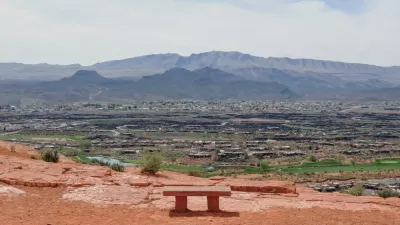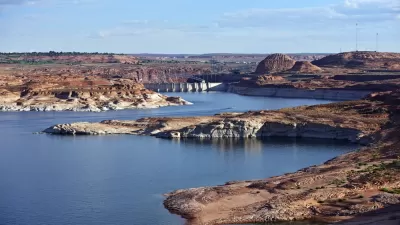Paiute Indians in Arizona oppose a plan to pipe Colorado River water from Lake Powell in Arizona to St. George in Utah, according to documents released by the U.S. Bureau of Reclamation.

"Any potential alignment of the Lake Powell pipeline would pass through lands that hold spiritual and cultural significance to Southern Paiutes, who fear the project would jeopardize their culture and upset the balance of nature," reports Brian Maffley.
The U.S. Bureau of Reclamation recently released the environmental impact statement for the proposed pipeline, revealing the concerns of the Kaibab Band of Paiute Indians about the project's intentions to divert Colorado River water to feed growing demand in the urban areas around St. George.
"Utah has a legal right to some of the Colorado’s flow and intends to put 6% of its share to use by piping it across northern Arizona and southern Utah for use in Washington County, whose population is expected to more than double by 2060 to nearly half a million," according to Maffley.
The environmental documents for the project present two alternatives: "One alternative route passes through Arizona’s Kaibab Indian Reservation and the other, preferred by the water project’s Utah proponents, skirts the reservation around its southern borders by following an existing utility corridor," writes Maffley.
FULL STORY: Lake Powell pipeline will ‘make the river angry,' Southern Paiutes warn as feds release analysis

Study: Maui’s Plan to Convert Vacation Rentals to Long-Term Housing Could Cause Nearly $1 Billion Economic Loss
The plan would reduce visitor accommodation by 25,% resulting in 1,900 jobs lost.

North Texas Transit Leaders Tout Benefits of TOD for Growing Region
At a summit focused on transit-oriented development, policymakers discussed how North Texas’ expanded light rail system can serve as a tool for economic growth.

Why Should We Subsidize Public Transportation?
Many public transit agencies face financial stress due to rising costs, declining fare revenue, and declining subsidies. Transit advocates must provide a strong business case for increasing public transit funding.

How to Make US Trains Faster
Changes to boarding platforms and a switch to electric trains could improve U.S. passenger rail service without the added cost of high-speed rail.

Columbia’s Revitalized ‘Loop’ Is a Hub for Local Entrepreneurs
A focus on small businesses is helping a commercial corridor in Columbia, Missouri thrive.

Invasive Insect Threatens Minnesota’s Ash Forests
The Emerald Ash Borer is a rapidly spreading invasive pest threatening Minnesota’s ash trees, and homeowners are encouraged to plant diverse replacement species, avoid moving ash firewood, and monitor for signs of infestation.
Urban Design for Planners 1: Software Tools
This six-course series explores essential urban design concepts using open source software and equips planners with the tools they need to participate fully in the urban design process.
Planning for Universal Design
Learn the tools for implementing Universal Design in planning regulations.
City of Santa Clarita
Ascent Environmental
Institute for Housing and Urban Development Studies (IHS)
City of Grandview
Harvard GSD Executive Education
Toledo-Lucas County Plan Commissions
Salt Lake City
NYU Wagner Graduate School of Public Service




























